For our midterm project, my partner Cindy and I have researched several projects to find more information about interaction. In my group project, we come up with an idea of “Skype 2.0”. We want to develop the app “Skype” into a sort of wearable VR device that can let the users feel like they are sitting in a real chatroom and enable them to chat with their friends which are far away face to face. We learn from the project that “interaction” include these elements –– two actors or more, input , process, output and a cyclic procedure of the three steps. My previous project doesn’t only help us understand the meaning of interaction, but also shed light on how interactive new devices help improve some products that already exist –– let the users more interested and engaged in the using of the product.
Our project is called “Library Noise Sensor”, which is a little cute figure that can react differently according the different noise level. We can put this figure into the library to remind people of the importance of being quiet in the common study space. Based on the fact that there are already some sound sensors in our school’s group study room, I interviewed one of our library staff Edward Lim about whether the sound sensors really improve the situation. He told me that although sensors will beep if voice was too loud, but most students ignored the beep and keep making noise. What’s more, it is ridiculous that the beep even makes it louder. Lim offered me a case that a kid library make the” book return” look like a cute monster to draw children’s attention.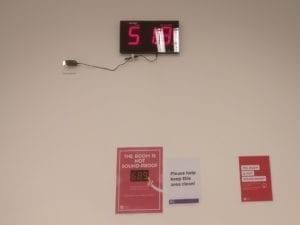

https://www.facebook.com/kayla.casiello/videos/10162253998475597/
Thus, we come up with an idea that we can make the sound sensor much more adorable to draw students’ awareness of the significance of being quiet instead of only showing some boring and “cold” numbers on the screen. Then, we work on finding ways to improve the sound sensor. We find “interaction” can be the best solution, which means that if the students are involved in a conversation, they will get more chance to realize the fact that they are making disturbing noise. There are similar cases that the hospital uses a device looks like a traffic light to show the sound level. We also find some cute interactive toys on youtube which we get inspiration from on the appearance of our sound sensor.
We make our library noise sensor into a figure that looks like a card box man. If the figure hear something that is a little bit noisy, it will put its book down and stare at you as a sign of dissatisfaction. If it is noisier, the card box man will put up a sign of “silence”, and if it is super noisy, it will keep putting the sign up and down to show its anger. The figure makes the situation looks like the man is listening to the students’ sounds and asking them to be quiet. The students then will receive the message and be quieter with reaction to it. There is always interaction because whether it is quiet or not, the figure is always reacting to the sound level ( keeping still is also a reaction to the quiet sound), and the students are always receiving and responding to the message delivered by the figure that they know whether they are quiet or not by seeing the posture of the figure.
Our sketch.
To make our project work, we decide to use the “digital write” to let our sensors make outputs of 0 and 1. If the voice level is higher than the standard noise, the output will be 1, and we use different analog sound sensors to define different noise levels by adjusting their sensitivity. We choose digital write instead of analog write because it is too complicated for our purposes — digital is enough. Then, we decide to use the “if” sentence to make the figure change its postures according to the output by making the motor move in different angles. The motors will be connected to the figures’ arms. The body will be made by our 3D printer because it is also too complicated for us to make a figure by wood or something else by our hand.
When we are making our project, we face several difficulties, but we successfully overcome them. First, we face the problem that our analog sound sensors are not sensitive enough that they can only tell the super quiet sound and the super loud sound apart. So we buy several new advanced sensors to solve it. However, although the new sensors manage to detect some noise that is not loud in real life but noisy in the library, it sill fail to detect three sound levels instead of two. So we change our code that we define the third noisy level as “being noisy for a long time” instead of “being super noisy”. We use a method of accumulation to make it work. If the sensor detect”noisy”, it will add a number to “s”, and “s” is added up to 4, it will be understood as “being noisy for a long time.” We face our second difficulty in our user testing session, we find that our motor will keep moving from the condition of “quiet” and “noisy” although people are keep on talking. It is because that the sensor just detect the pause time of a conversation. Our fellows tell us maybe we should use a new method that sets a precise time schedule of every movement instead of using the “delay” code. However, we fail to use this kind of complex code. But we come up with an idea that is quite similar to the accumulation method. That is, if there is one “quiet”, the code will minus 1 to “s” and add 1 to “t” which is originally 0, only when the “t” becomes 10, the motor will react as “being quiet”. Minus here works for avoiding the situation that if there is two noisy times which happen between a long break, the figure still act as “being noisy for a long time” when s becomes 4.
Finally, our project works like this.
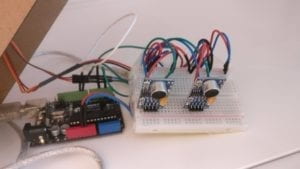
Our code looks like this.
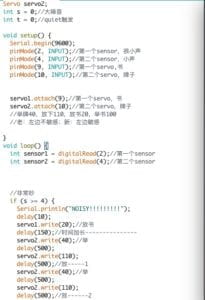
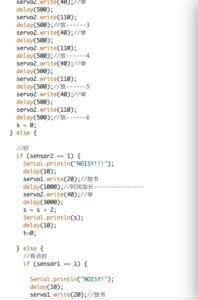
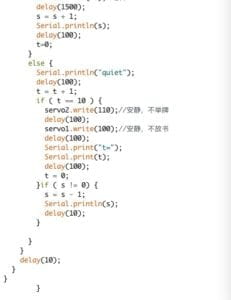
In conclusion, our project aims at making a much more useful sound sensor that can be used in the library to ask the students to be quiet. We use a kind of interactive cute figure to draw the audience’s attention and make the warning more persuasive than only showing the boring numbers to student. Our project aligns with our definition of interaction because there is a procedure of “input, process and output” between the figure and the students when there is something noisy . However, there is one problem that it maybe hard to find something interactive when the students are quiet. Ultimately, my audience interact with our project by sending voice to it, receiving the feedback made by it, and change their voice volume as reaction. If we have more time, we will take the advice given by fellows and change our code into a more precise way to detect the sound volume of a conversation, which ignores the pause. From the setbacks, we learn that maybe sometimes we can find some way that maybe not so perfect, but can still fulfill our goals with replacing the complicated method and make the creating process easier. From the accomplishment we also learn something that sketches and plans are necessary before we are making a project, which helps us save a lot of time and remind us of what we are going to do next when we are confused. I wish maybe our project could be applied to our school library one day that really makes our library quieter and funnier.
References:
https://www.facebook.com/groups/ALAthinkTANK/permalink/2995666503839483
https ://www.youtube.com/watch?v=2SJGNwzP-Qs
https ://www.youtube.com/watch?v=WyssV2MQsps
